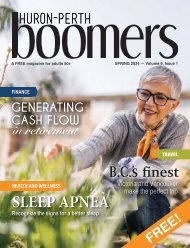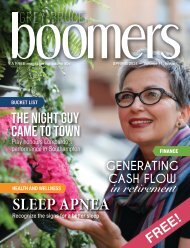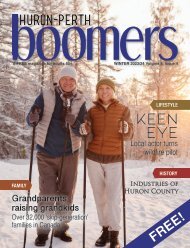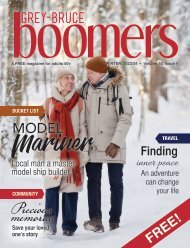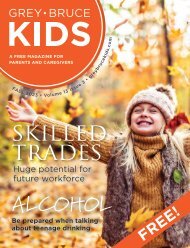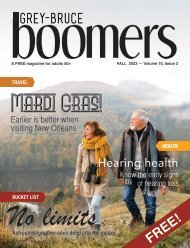Grey Bruce Kids Fall 2021
You also want an ePaper? Increase the reach of your titles
YUMPU automatically turns print PDFs into web optimized ePapers that Google loves.
Weina Chong was around 10 years old when she<br />
remembers first being exposed to what is commonly<br />
referred to as STEM — science, technology, engineering and<br />
math.<br />
It wasn’t from a book — it was from a toy.<br />
“My parents got me a construction and assembly-type toy that<br />
allowed you to build your own motorized vehicle,” Chong<br />
explained, nearly 25 years after first laying hands on the toy. “My<br />
dad and I would spend hours building and taking apart the cars.”<br />
Chong’s interest in STEM stayed with her as she discovered<br />
more about what it included, and she began taking courses in<br />
machine shop, drafting and computer-aided-design. Through<br />
these courses, she recognized a passion she never knew she had,<br />
which was working with her hands. She also discovered she<br />
was quite good at drawing and visualizing things. She began to<br />
research what university program would best suit her skills, and<br />
she found one in engineering.<br />
Around the same time, Sarah Patterson was also trying to<br />
discover what best suited her when it came to post-secondary<br />
studies and deciding on a career. As a kid, she loved learning<br />
everything, not just STEM-related courses. Her love of learning<br />
is something she still has today.<br />
“I used to spend time helping my dad with construction projects<br />
around the house,” Patterson said. “But I also enjoyed sports,<br />
reading, listening to music, playing video games, and hanging<br />
out with my friends. I definitely did not fit the stereotype of<br />
someone who would go into engineering or another STEM<br />
field, but I’ve found that most people don’t.”<br />
While Chong was building cars with her dad with that<br />
motorized toy, and Patterson was helping her dad with<br />
construction projects around the house, across the province<br />
a woman Chong and Patterson didn’t yet know was blazing a<br />
trail for women – not just in STEM, but in Canada’s nuclear<br />
industry. Tracy Primeau was always good at math and science,<br />
but decided she wanted to be a teacher — at least until she was<br />
attending the University of Waterloo and learned two things.<br />
The first was that she didn’t think she wanted to spend the rest<br />
of her life around high schoolers after all. The second was that<br />
she was really good at working with computers.<br />
“Remember, this was 1986, so programming was a pretty new<br />
item to major in and I was fortunate enough to get a job as a<br />
Teaching Assistant (TA) in that department,” she said.<br />
While Primeau considered her options with her major, her dad,<br />
who had worked in the nuclear industry since his daughter was<br />
three, told her about an opportunity in Operations at Ontario<br />
Hydro. Primeau’s youngest sister also followed their dad’s<br />
footsteps into the energy industry.<br />
“(She) is an electrical engineer and, like me, Indigenous,”<br />
Primeau said. “She has gone from working in the energy<br />
industry at the Independent Electricity System Operator (IESO)<br />
to becoming the President and CEO of the Canadian Council<br />
of Aboriginal Business (CCAB).”<br />
While women in Operations roles in nuclear are more common<br />
today, in the late-80s there were no role models for Primeau to<br />
look up to. Going into Operations meant she would be forging<br />
her own path.<br />
“There were not a lot of women on my shift, (just) one other<br />
female operator, a control tech, and a woman in the lab,” said<br />
Primeau, who recently retired after 31 years in the industry. “No<br />
one in the control room or in leadership positions at all. The<br />
construction office we took breaks in was covered in pin-ups.”<br />
Physical strength and height were the two biggest differences<br />
often pointed out between her and her male colleagues. Instead<br />
of focusing on how she didn’t literally measure up in those areas,<br />
Primeau decided to make it an advantage. She could operate<br />
valves using her bodyweight as a lever and fit into equipment<br />
others couldn’t.<br />
“As time went on it became clear that my gender and size was a<br />
win when someone needed to go into a condenser water box or a<br />
steam drum or boiler, and I could fit in and stand up once inside.”<br />
In <strong>2021</strong>, it may surprise you to learn that the number of women<br />
in STEM-related fields remains very low, even while women make<br />
greybrucekids.com • 11






